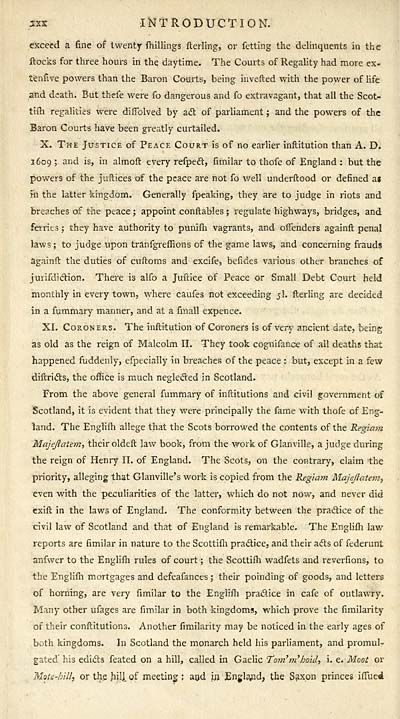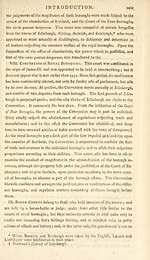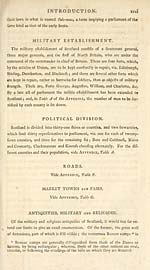Gazetteer of Scotland
(38) Page xxx
Download files
Complete book:
Individual page:
Thumbnail gallery: Grid view | List view

zxx INTRODUCTION.
exceed a fine of twenty fhillings fterling, or fetting the delinquents in the
flocks for three hours in the daytime. The Courts of Regality had more ex-
tenfive powers than the Baron Courts, being invefted with the power of life
and death. But thefe were fo dangerous and fo extravagant, that all the Scot-
tifh regalities were diffolved by ad: of parliament ; and the powers of the
Baron Courts have been greatly curtailed.
X. The Justice of Peace Court is of no earlier inftitution than A. D.
3609 ; and is, in almoft every refpect, (imilar to thofe of England : but the
powers of the juftices of the peace are not fo well underftood or defined al
in the latter kingdom. Generally fpeaking, they are to judge in riots and
breaches of the peace ; appoint conftables ; regulate highways, bridges, and
ferries ; they have authority to punifh vagrants, and offenders againft penal
laws ; to judge upon tranfgrefiions of the game laws, and concerning frauds
againft the duties of cuftoms and excife, befides various other branches of
jurifdiction. There is alfo a Juftice of Peace or Small Debt Court held
monthly in every town, where caufes not exceeding 5!. fterling are decided
in a fummary manner, and at a fmall expence.
XL Coroners. The inftitution of Coroners is of very ancient date, being
as old as the reign of Malcolm II. They took cognifance of all deaths that
happened fuddenly, efpecially in breaches of the peace : but, except in a few
diftricts, the office is much neglected in Scotland.
From the above general fummary of inftitutions and civil government of
Scotland, it is evident that they were principally the fame with thofe of Eng-
land. The Englifh allege that the Scots borrowed the contents of the Regiam
Majeftatem, their oldeft law book, from the work of Glanville, a judge during
the reign of Henry II. of England. The Scots, on the contrary, claim the
priority, alleging that Glanville's work is copied from the Regiam Majeftatem?
even with the peculiarities of the latter, which do not now, and never did
exift in the laws of England. The conformity between the practice of the
civil law of Scotland and that of England is remarkable. The Englifh law
reports are (imilar in nature to the Scottifh practice, and their acts of federunt
anfwer to the Englifh rules of court ; the Scottifh wadfets and reverfions, to
the Englifh mortgages and defeafances ; their poinding of goods, and letters
of horning, are very fimilar to the Englifh practice in cafe of outlawry.
Many other ufages are fimilar in both kingdoms, which prove the fimilarity
of their conftitutions. Another fimilarity may be noticed in the early ages of
both kingdoms. In Scotland the monarch held his parliament, and promul-
gated' his edicts feated on a hill, called in Gaelic Tom'm'houl, i. e. Moot or
Mots-bill, or the hi!], of meeting : and in England, the Saxon princes iflued
exceed a fine of twenty fhillings fterling, or fetting the delinquents in the
flocks for three hours in the daytime. The Courts of Regality had more ex-
tenfive powers than the Baron Courts, being invefted with the power of life
and death. But thefe were fo dangerous and fo extravagant, that all the Scot-
tifh regalities were diffolved by ad: of parliament ; and the powers of the
Baron Courts have been greatly curtailed.
X. The Justice of Peace Court is of no earlier inftitution than A. D.
3609 ; and is, in almoft every refpect, (imilar to thofe of England : but the
powers of the juftices of the peace are not fo well underftood or defined al
in the latter kingdom. Generally fpeaking, they are to judge in riots and
breaches of the peace ; appoint conftables ; regulate highways, bridges, and
ferries ; they have authority to punifh vagrants, and offenders againft penal
laws ; to judge upon tranfgrefiions of the game laws, and concerning frauds
againft the duties of cuftoms and excife, befides various other branches of
jurifdiction. There is alfo a Juftice of Peace or Small Debt Court held
monthly in every town, where caufes not exceeding 5!. fterling are decided
in a fummary manner, and at a fmall expence.
XL Coroners. The inftitution of Coroners is of very ancient date, being
as old as the reign of Malcolm II. They took cognifance of all deaths that
happened fuddenly, efpecially in breaches of the peace : but, except in a few
diftricts, the office is much neglected in Scotland.
From the above general fummary of inftitutions and civil government of
Scotland, it is evident that they were principally the fame with thofe of Eng-
land. The Englifh allege that the Scots borrowed the contents of the Regiam
Majeftatem, their oldeft law book, from the work of Glanville, a judge during
the reign of Henry II. of England. The Scots, on the contrary, claim the
priority, alleging that Glanville's work is copied from the Regiam Majeftatem?
even with the peculiarities of the latter, which do not now, and never did
exift in the laws of England. The conformity between the practice of the
civil law of Scotland and that of England is remarkable. The Englifh law
reports are (imilar in nature to the Scottifh practice, and their acts of federunt
anfwer to the Englifh rules of court ; the Scottifh wadfets and reverfions, to
the Englifh mortgages and defeafances ; their poinding of goods, and letters
of horning, are very fimilar to the Englifh practice in cafe of outlawry.
Many other ufages are fimilar in both kingdoms, which prove the fimilarity
of their conftitutions. Another fimilarity may be noticed in the early ages of
both kingdoms. In Scotland the monarch held his parliament, and promul-
gated' his edicts feated on a hill, called in Gaelic Tom'm'houl, i. e. Moot or
Mots-bill, or the hi!], of meeting : and in England, the Saxon princes iflued
Set display mode to: Large image | Transcription
Images and transcriptions on this page, including medium image downloads, may be used under the Creative Commons Attribution 4.0 International Licence unless otherwise stated. ![]()
| Gazetteers of Scotland, 1803-1901 > Gazetteer of Scotland > (38) Page xxx |
|---|
| Permanent URL | https://digital.nls.uk/97343884 |
|---|

